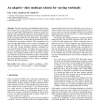Free Online Productivity Tools
i2Speak
i2Symbol
i2OCR
iTex2Img
iWeb2Print
iWeb2Shot
i2Type
iPdf2Split
iPdf2Merge
i2Bopomofo
i2Arabic
i2Style
i2Image
i2PDF
iLatex2Rtf
Sci2ools
MMS
2002
2002
An adaptive video multicast scheme for varying workloads
Periodic broadcast and scheduled multicast have been shown to be very effective in reducing the demand on server bandwidth. While periodic broadcast is better for popular videos, scheduled multicast is more suitable for less popular ones. Work has also been done to show that a hybrid of these techniques offer the best performance. Existing hybrid schemes, however, assume that the characteristic of the workload does not change with time. This assumption is not true for many applications, such as movie on demand, digital video libraries, or electronic commerce. In this paper, we show that existing scheduled multicast techniques are not suited for hybrid designs. To address this issue, we propose a new approach and use it to design an adaptive hybrid strategy. Our technique adjusts itself to cope with a changing workload. We provide simulation results to demonstrate that the proposed technique is significantly better than the best static approach in terms of service latency, throughput, d...
| Added | 22 Dec 2010 |
| Updated | 22 Dec 2010 |
| Type | Journal |
| Year | 2002 |
| Where | MMS |
| Authors | Kien A. Hua, Jung-Hwan Oh, Khanh Vu |
Comments (0)

